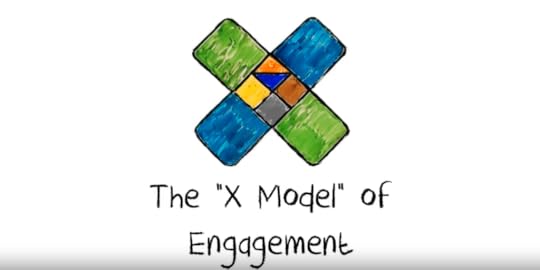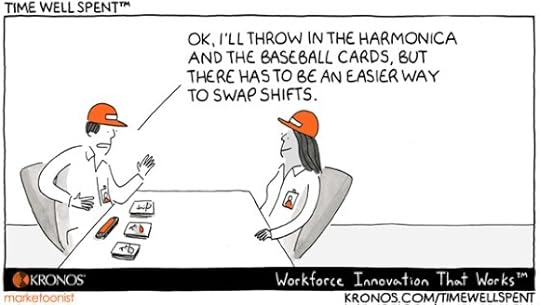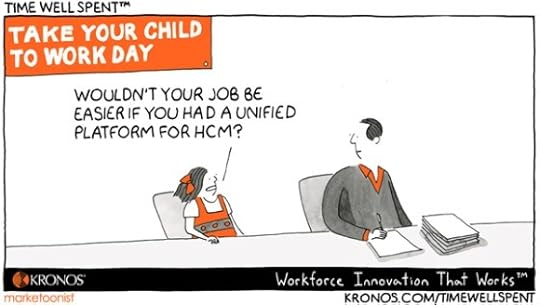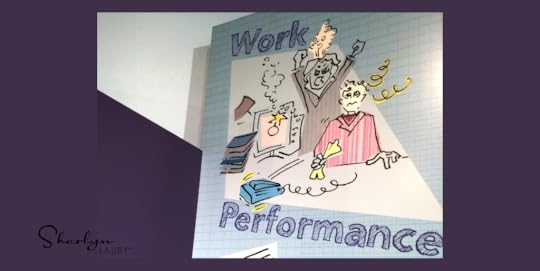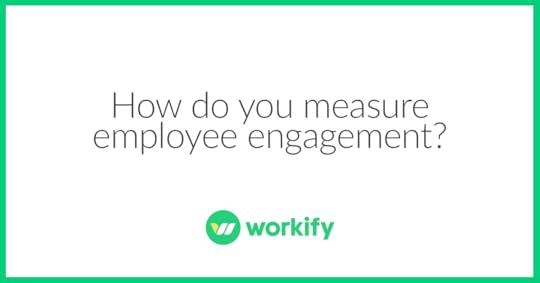Sharlyn J. Lauby's Blog, page 137
May 16, 2017
Employee Engagement Defined
If someone asked you to define employee engagement in a single sentence, what would you say?
Back in 1964, U.S. Supreme Court Justice Potter Stewart coined the phrase “I know it when I see it.” to describe his threshold test for obscenity. I do sometimes wonder if employee engagement is like porn. We all know what employee engagement means, right? Because “I know it when I see it.”
We see the term ”employee engagement” everywhere. There are countless articles on the subject. But if somebody asked you to describe employee engagement in one sentence, what would you say?
No disrespect to Justice Stewart, but employee engagement has become too important to completely rely on the “I know it when I see it” as the one sentence definition. So, I challenged myself to find a concise explanation for employee engagement.
It’s not as easy as it looks. We talk about employee engagement in terms of outcomes like high productivity and better profits. We also like to mention it in relation to improved manager – employee communications. Those are all important but it really doesn’t articulate what employee engagement is. Then, thanks to BlessingWhite and this video titled, “The ‘X’ Model of Employee Engagement”, I think I found it.
I believe the video does a nice job of explaining engagement in a succinct manner. Employee engagement lies at intersection of maximum contribution for the business and maximum satisfaction for employees. It’s a sustainable level of high performance that benefits both the company and the employee.
Finally, a real definition of employee engagement.Click To Tweet
Sometimes I wonder if the reason companies are having so much difficulty with employee engagement is because they are operating with a vague definition. They know it’s important but can’t articulate it. And if organizations can’t define it, how do they know that managers “know it when they see it”? The first step to solving any challenge is being able to agree on the definition.
The post Employee Engagement Defined appeared first on hr bartender.






May 14, 2017
How to Reduce Individual Stress Levels at Work
During this year’s BetterWorks Goal Summit, closing keynote speaker Srikumar Rao, author of the book, “Happiness at Work: Be Resilient, Motivated, and Successful – No Matter What”, shared with us his views on stress and goals. I must admit, it was a great way to wrap up our day.
I don’t know about anyone else…but I love going to conferences for the learning and ideas. At the same time, I also find myself creating massive “to-do” lists for myself – things I want to look up or read, projects I should start, and overall reminders of habits that I need to start doing again. Of course, this means I’m learning and adding to my own stress.
Stress continues to be is a major issue for employees and organizations. And there are many reasons for it. Rao shared several and I found they fell into three buckets: individual, work, and life.
The “me” issues.
I’m putting in this category financial stressors such as not having enough money or savings. Or if you’re a freelancer, not having customers pay on time.
Health issues like not feeling well and the stress associated with trying to resolve health insurance issues. Fighting with insurance companies can really take a toll.
We love our family and friends, but sometimes they get on our nerves. And we get on theirs. Dealing with misunderstandings, gatherings, and holidays can be stressful.
The workplace stuff.
Our careers don’t always move as fast as we would like. It can be frustrating. We think we’re ready for a promotion (and more money). Or we want to be on a special project that will get us noticed.
Too much work! We never seem to get a breather to get organized and focus on our goals. We no sooner get done with one project and another one is dropped on our desk.
And let’s face it…sometimes our boss, co-workers, and customers can be a PITA. I’m sure there are days they feel the same about us. It’s all part of work.
Life in general.
Regardless of your political affiliation, it’s hard to escape today’s political environment. It’s on our Facebook pages and everyone wants to share their point-of-view. Whether we want to engage or not…
Time is precious and we don’t always have as much as we would like. We’re thinking there’s no such thing as work-life balance, or work-life integration, etc.
As you can see, these examples aren’t mutually exclusive. Politics at work = stress. No work life balance = hard on relationships.
Now you might be saying to yourself, “Yep, I knew all of these things are stressors. I don’t need someone to tell me what I already knew. Tell me how to make the stress go away!” Well, that’s the interesting part. Rao says that the reason we have stress is because we have a rigid idea of what the universe should be like and the universe isn’t cooperating.
Stress is the result of control. And the key to reducing stress is realizing that we aren’t in control. And we never will be. But we can learn how to manage control better.
Stress – How to Manage our Need for Control
Rao outlined three activities we can do to manage our need for control.
Practice appreciation and gratitude. This could also be in the form of mindfulness. Rao pointed out that we tend to spend more time focused on the things that are wrong around us instead of focusing on the things that are right. He suggested that things are only bad if we say they are. It’s important for us to reframe change in the context of the things we appreciate versus the stuff we can’t stand.
Become aware of mental chatter. Speaking of focusing on positive messages, that also goes for the messages we send to ourselves. I refer to this as self-talk. It’s that little voice inside our head. Does it send us positive messages or negative ones? We should make sure our mental chatter doesn’t wear us out. It will take some time and activities like mindfulness could help.
Invest in the process, not the outcome. Rao shared his view that we are a goal obsessed society. That’s not necessarily a bad thing. Goals are important because they set direction. What we need to change is the mindset that if I meet the goal, that’s great and if I don’t, that’s bad. The experience is equally as important as the outcome. Rao suggests, “The more detached you are from the goal; the higher the probably that you will achieve it.”
Think Like a Civil Engineer
Rao compared the steps for managing control to being an engineer. You have a road to build. How are you going to handle the obstacles (i.e. stress)? Because we know the project will have some speedbumps along the way (pun intended). But the road still has to be built. So, we need to learn ways to manage those obstacles.
Managing the stress in our personal and professional lives isn’t easy. But I can definitely see how trying to control everything adds to our stress. And learning how to manage control could be helpful.
Thanks to Author Andrea Beaty for sharing this image (and others!) with the March for Science organizers around the world.
The post How to Reduce Individual Stress Levels at Work appeared first on hr bartender.






May 12, 2017
Employees Value Benefits Differently – Friday Distraction
Organizations work very hard to provide consistency. They want customers to have a consistent experience. And I believe they want employees to have a consistent experience as well. That’s one of the reason companies develop benefit packages. They want to offer employees consistency in their workplace.
There’s one challenge with that though…employees place a different value on things. Today’s Time Well Spent from our friends at Kronos reminds us that employees even value schedules differently.
I realize that organizations can’t give every employee their own unique benefits and perks package. And, I’d suggest that you really don’t want to. Years ago, I worked for an employer and, because the company was small, employees could negotiate their own deals. It was a nightmare for HR. Everyone had something unique about their benefits. It was impossible to remember all the details. So anytime an employee asked a question, it was a major researching exercise, because you had to look up the employee’s special deal.
But that doesn’t mean that there aren’t opportunities for organizations to do a little customization and give employees control over the things they value.
For example, I know lots of companies that give employees the ability to select their own gifts in recognition or wellness programs. It might not sound like a lot but I’ve heard comment from many employees like, “I did INSERT ACTIVITY HERE and earned enough points to buy INSERT ITEM HERE.” Employees conveyed pride in being able to earn and select their own reward.
Other benefits like telework and unlimited vacation give employees flexibility, which allows the individual to make some decisions about value. There are organizations that offer employees time off to volunteer in the community. Again, an opportunity for employees to make decisions about value.
Maybe it’s time for organizations to figure out how to give employees a consistent experience…by giving them choices. The company wins because they can consistently explain the benefit. Employees win because they get to choose the things they value most.
The post Employees Value Benefits Differently – Friday Distraction appeared first on hr bartender.






May 11, 2017
Talent Acquisition Strategy: The 3 Tactics Your Organization Needs
I listened in on a panel discussion during this year’s SHRM Talent Management Conference when I hear a recruiter say, “My job is to fill openings.” And I thought to myself, “Hmm…no. A recruiter’s job is to fill the company’s talent pipeline.”
Now you might be saying to yourself, “Same thing.” But I’m not sure it is. Hear me out.
From a process perspective, organizations hire employees from their talent pipeline. So if the pipeline is full of quality candidates, the company will have people to fill jobs. Recruiters would make their lives easier if they keep the talent pipeline full because candidates will be there when the company has an opening.
But I think there’s an added dimension to recruiting that needs to be addressed. Not every job opening can and will be filled with an external hire. If talent acquisition is going to be responsible for finding the best talent, then they need to work with the learning and development function to develop employees from within the organization. They also need to work with compensation and benefits to determine if full-time jobs would be better as part-time or ideal for freelancers.
I recently partnered with Alongside to publish a series of articles on the three talent acquisition strategies that organizations should consider:
Using a “Buy” Recruiting Tactic to Find Talent
Filling Your Talent Needs with “Build” Recruiting Tactics
Leveraging “Borrow” Recruiting Tactics to Meet Your Staffing Needs
I don’t have to tell anyone that hiring is getting tougher. The only way companies are going to win the war for talent is by giving talent acquisition professionals the responsibility and tools to do their job. That’s not simply filling requisitions. It’s helping the organization keep their talent pipeline full, whether that’s with candidates, full-time employees, part-time employees, or freelancers.
Your talent pipeline is more than a bunch of external candidatesClick To Tweet
The talent pipeline is more than a pipeline of external candidates. It’s all of the organization’s talent. And that’s a pretty big pipeline. And today, businesses can afford to have it run dry.
Image captured by Sharlyn Lauby outside the Hard Rock Casino in South Florida
The post Talent Acquisition Strategy: The 3 Tactics Your Organization Needs appeared first on hr bartender.






May 9, 2017
3 Steps to Make Recruiting Your Competitive Advantage
Prior to the Society for Human Resource Management (SHRM) Talent Management conference, I was able to attend the TAtech Spring Congress. The TAtech event was super interesting and I can’t wait to share with you some of my takeaways over the coming weeks.
One of the big takeaways for me was a session by Jerome Ternynck, founder and CEO of SmartRecruiters. He was talking about making recruiting your organization’s competitive advantage. Here’s the bottom-line: If organizations want talent to be their competitive advantage… If they want a best in class candidate and employee experience… If companies want a kickass employment brand… then recruiting has to become a competitive advantage for the organization. So, how does that happen? Well over my time at SHRM Talent Management and TAtech, I heard three things:
Properly staff your talent acquisition team. If recruiting is marketing, then organizations need to start putting their money where their mouth is. I’ve never worked for a company where sales and marketing positions were filled using requisitions. When a great sales person was identified, they were hired. We found the budget. Sales was that important. If talent is important to the company, then start doing the same for recruiters.
Train the talent acquisition team. Everybody needs training. Everybody. It undermines the credibility of the talent acquisition function to look for candidates that are self-learners and then not do the same for themselves. Professional development can improve morale, engagement, and retention. Organizations should want the individuals selling people on working for the company to be as excited as the candidates.
Give recruiters the tools. New recruiting tools are coming out all the time, especially in technology. Recruiters need to be exposed to those new tools, so they can determine if they’re right for the organization. True – There are some old-school recruiting methods that are still very effective and those shouldn’t be abandoned. But recruiting sources should be regularly evaluated for their effectiveness.
If you want to hire the best talent, recruiting must be a competitive advantageClick To Tweet
Organizations don’t expect understaffed, untrained marketing departments with outdated technology to deliver high performance. Well, maybe some of them do…but I’d wager they don’t always get the results they’re looking for. The same is true for talent acquisition. If organizations want the best talent, they need to give the talent acquisition function the people, training, and resources to effectively execute the recruiting strategy.
Image captured by Sharlyn Lauby after attending the Great Place to Work Conference in Austin, TX
The post 3 Steps to Make Recruiting Your Competitive Advantage appeared first on hr bartender.






May 7, 2017
Recognizing Public Service Employees – #PSRW
(Editor’s Note: Today’s post is brought to you by our friends at Kronos , a leading provider of workforce management and human capital management cloud solutions. Kronos recently announced that, for the 17th consecutive year, they have been awarded the NorthFace ScoreBoard Award for excellence in customer service . Congratulations! Enjoy the post.)
Employee recognition is important. It’s good for employee morale, engagement, and retention. And not just on an individual level. Organizations are recognizing groups of employees during workplace recognition days like Customer Service Week (the first full week of October) and Administrative Professionals Week (typically held in April). As a human resources professional, it’s good to see more organizations recognizing the work of their employees.
I’m also seeing organizations recognize employees who serve their community. Businesses understand that there’s a whole group of people who don’t work for the company but play a role in their success. One such group of individuals that every community relies upon are public servants. If you weren’t aware, this week is Public Service Recognition Week (PSRW). It’s been celebrated since 1985.
Public servants include first responders (i.e. police, fire, and emergency services). They’re all government employees across local, state, and federal governments. In addition, education employees across K-12 and higher education, including student employees at universities. Public service employees play a huge role in our communities.
To celebrate Public Service Recognition Week and the important work being done in our communities, our friends at Kronos created a video – “The Heroes of Public Service”.
Public service employees not only make our communities safer and better, but they touch individual lives. Rock Regan, director of the public-sector practice group at Kronos, shared with me a very personal story about what public service means to him.
“I was eight years old. Several friends of mine and I had decided to go tobogganing. Unfortunately, while we were out having fun, we crashed into a school fence. The good news was it wasn’t with a thud, but the toboggan dug in and slid effortlessly beneath the fence. My legs tucked in and were pinned under the tines of the fence.
Realizing it was serious, my friends knew it was time to go for help. The closest house was just a few hundred yards away and off they went. Moments later, I could hear the siren roar of Engine Six from our neighborhood firehouse and I knew help was on the way.
As I waited to be cut free, I remember thinking, ‘Thank god for the people who run to you in time of need, and give you the coat off their back in the middle of a storm to keep you warm and safe.’
For well over 20 years, I’ve had the privilege to be involved in the public sector. I know first-hand of the heroes that most never think of. The people like custodians who keep our schools maintained and clean, the road crews who fill in the potholes, the folks who run the programs at the parks, the caseworkers who keep children at risk safe, and the database administrators who make sure police officers get the latest information sent to their mobile computers. The list goes on and on. There are so many other public service heroes and we don’t do nearly what we should to show just how much we appreciate them.”
Thanks to all the Heroes of Public Service - #PSRWClick To Tweet
Public service employees are an integral part of the organizations they serve. They contribute to the education, safety, security, and efficiency of our communities. On some level, they’re an extension of our private sector workforce, because we couldn’t achieve our goals without them. They help our communities thrive, which in turn helps our businesses.
So, if you know a public service employee, take a moment to thank them for their hard work. And I hope you’ll share this post to thank the all the other public service employees who work in our communities every day. Thanks!
The post Recognizing Public Service Employees – #PSRW appeared first on hr bartender.






May 5, 2017
Kids Need Career Development – Friday Distraction
I know I’m a little late with a reference to “Take Our Kids to Work Day” but I believe the concept is one we should embrace year around. It’s important for us to expose kids to work. Because someday they’re going to enter the workforce and we want them to be prepared.
In career development, that first level – often labeled entry – is where we learn those key attributes of being a good employee. You know, like showing up to work on time, professional behavior expectations, and teamwork. Those skills we take with us to every other job we will ever have.
Activities like “Take Your Kids to Work Day” let young people see those career development behaviors in action. They get to witness first-hand how work happens. Kids might decide they want to be an accountant, sales person, graphic designer, or HR professional based on their exposure to the workplace.
Today’s Time Well Spent from our friends at Kronos is also a good reminder that sometimes an outsider can bring a level of clarity and creativity to the work problems we deal with every day. Not every problem can be solved by an outsider but, there are times when the answer is staring us right in the face and we can’t see it. When we need to refocus, here are a couple of things to consider:
Put the problem aside. I understand this isn’t always possible, but even going out for lunch or a walk around the building, can allow the mind to wander just enough. You can return fresh and ready to refocus.
Brainstorm new ideas. Bring a group together to brainstorm some new thoughts. Creating some diverse ideas could be the breakthrough needed to jump start the project.
As part of our career development, we need to be able to step away and refocus on issues when they occur. But we also need to be prepared to educate young people on what it takes to be successful in today’s work environment. It’s a win for everyone involved.
The post Kids Need Career Development – Friday Distraction appeared first on hr bartender.






May 4, 2017
5 Deskercises to Keep You Active at Work
One of the things I love about my health insurance company is that they offer webinars and workshops to both members and the community. I’ve been able to get the latest info from a doctor about the Zika virus. They also hold nutrition workshops. Recently, I attended a Deskercise workshop (aka activities we can do at our desk).
Because I work from home, I’m very conscious of the need to get active. We’ve all heard that sitting is bad for us. Physical activity improves our focus, mood, and energy. It can benefit our blood pressure, cholesterol, and stress levels. So, what are a few activities that we can do? Well, here are five that were shared during the workshop.
Wooden Legs – This is an activity you can do while sitting at your desk. Sit upright in your chair and extend one leg out straight in front of you. Hold for two seconds. Then raise it up higher, hold for two more seconds. Repeat each leg 10 times. Great to do during webinars or long conference calls!
Calf Raises – Next time you’re waiting for the printer or copier, push up on your tippy toes, pause at the top, then lower back down. Repeat for 3 sets of 10 reps.
Silent Glute Squeeze – Refrain from snickering on this one. You don’t have to announce to your co-workers when you’re doing it! Try isometric glute squeezes by simply squeezing the buttocks, holding for 5-10 seconds, and releasing. Do this while typing one complete email. Not only will it help you write concise messages but the results will be uplifting!
Shadow Boxing – This could be helpful during a frustrating day. Pretend you’re a boxer. With knees soft and core tight, throw out some punches in rapid succession. Continue for a minute or longer to blow off some steam and tone your arms, shoulders, and core.
Dance Party – When you feel like celebrating, break out your favorite active dance moves. If you don’t want anyone to see you, stay low and chair dance. Otherwise, stand up and let loose! Boogie for 30 seconds, rest, and repeat.
Doing these activities – even in short bursts – can have a benefit. Remember, before starting any type of exercise or activity program – even deskercise, be sure to talk with your physician. And, don’t make the assumption these activities are easy. Take things slowly and stretch before you get active. If you wear heels, consider removing them. And be sure to really focus on what you’re doing because form matters!
Oh, and one more thing. Get your co-workers involved! Maybe you can find a buddy to hold each other accountable.
Adding a few activities to our day takes a little commitment. But it can reap big results.
Oh, and P.S. I just discovered an app called Zova that allows you to do short exercises throughout the day with a prompt from your phone. The app offers video instruction so you can do the activity properly. It also lets you rate the activity so you do more of the things your like (and less of the ones you don’t). The idea being – turn these short bursts of activity into a habit.
Image captured by Sharlyn Lauby wandering around in South Florida
The post 5 Deskercises to Keep You Active at Work appeared first on hr bartender.






May 2, 2017
The Key to Employee Engagement: Your Net Promoter Score
(Editor’s Note: Today’s post is brought to you by Workify , an all-in-one people management software platform. Workify is a technology-enabled service that helps companies measure and trend employee engagement over time through continuous feedback loops. Enjoy the post!)
It’s sad to say but businesses don’t appear to be really moving the needle when it comes to employee engagement. I ran across this article from Gallup that reports managers account for 70 percent variance in employee engagement. I still believe part of the reason companies are struggling with engagement is they are having a hard time defining what engagement looks like and, as such, managers can’t identify or measure it. But what if there was an engagement related metric that organizations easily understood?
Net Promoter Score (NPS) is a common business index that measures the likeliness of customers recommending the company’s products or services. Think of it as “refer-ability”. The reason organizations use NPS as a business metric is because they can see a clear line of sight between it and business success. The more referrals the company receives, the more business they get, and the more profitable they would be.
Employee Net Promoter Score
Now let’s take the NPS concept and apply it to employee engagement. Employee Net Promoter Score (eNPS) is an index that measures the likelihood that an employee would refer candidates or customers to the company. The logic is similar: the better the organization is as an employer, THEN the more employees are engaged and satisfied with their work, AND the more people they will recommend.
Workify’s research and analysis of best practice methodologies found there were four common themes (aka the 4C’s) driving eNPS:
Commitment to contribute to the future success of the company
Connection to the community they work in, whether to its mission, its goals, or its people
Ability to make a contribution by performing great work every day
Readiness to challenge themselves to improve, and challenge the company to go further as well
I recently had the opportunity to talk with Stephen Huerta, CEO of Workify about how they developed their eNPS model and their approach. “We believe that engagement is driven through the individual experience an employee is having. As a result, we start with an employee-centric perspective on engagement and culture. We started by looking at the attributes of highly engaged employees and the key motivating factors that lead people, and teams, to do great work. Our 4C’s (commitment, connection, contribution, and challenge) are the key levers that drive engagement from the individual employee perspective but can be influenced by 8 additional indicators we monitor at the organizational level.” The 8 additional indicators are reflected in Workify’s eNPS model.
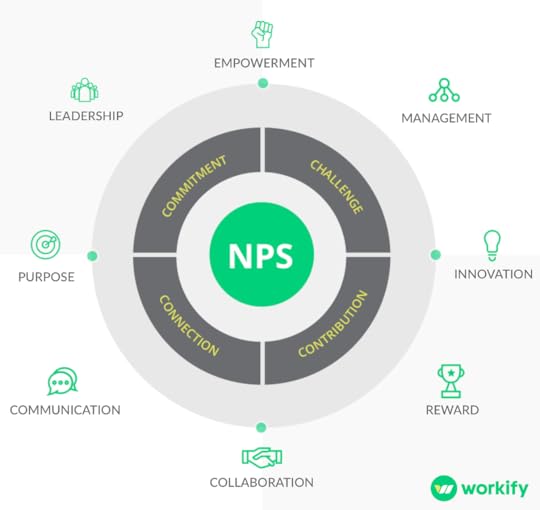
I know when it comes to employee satisfaction, many of us feel we’ve seen it all and don’t get excited about the conversation. But I have to say, the eNPS conversation is different and it’s worth paying attention to for three reasons.
It’s a familiar business term. The Society for Human Resource Management (SHRM) competency model includes business acumen as a key skill for human resources professionals. We’ve heard it before – HR pros need to speak the language of business. NPS is the language of business. So, let’s use it to talk about engagement in a business context.
For organizations focused on addressing employee satisfaction, making a connection between NPS and eNPS could help create buy-in and it could bring agreement among the management team about how to address the issue.
It’s measurable. Organizations measure their NPS on a regular basis, like profit and loss statements. The same can be done with eNPS. Today’s technology allows organizations to regularly take a pulse on the workforce, in real time. In addition, organizations can use other metrics – like referrals – as a visible metric that the company’s eNPS is thriving.
Chances are organizations are already tracking some referral metrics, so this becomes a good secondary barometer that the eNPS is accurate. It can also send a flag that the eNPS is in trouble if referral activity declines.
It aligns with the company. I don’t know of a single company that doesn’t want happy employees and referrals. Even if you’re a non-profit entity or public organization – you still want satisfied employees and candidate referrals. Having a healthy referral mechanism benefits the bottom-line. That’s why NPS and eNPS matter.
Many organizations tell employees “everyone is a part of the sales department” or “everyone is a part of the recruiting team”. If that’s true, then NPS and eNPS are key components in organizational culture and strategy. Organizations cannot rely on everyone to get things done and ignore employee satisfaction.
I must admit that I found eNPS a pretty simple model, which is what excites me about Workify’s model. Huerta agrees, but reminds us that employee engagement is complex, which is why it’s so hard for people to define. “For organizations that might be skeptical about eNPS and the connection with the 4C’s, my first response would be that, ‘it’s not that simple’. There are essentially three dimensions of engagement we assess:
Organizational factors that motivate or demotivate employees (i.e., 8 indicators),
Employee drivers of engagement (4C’s), and;
Employee satisfaction (i.e., eNPS).
Looking at any single dimension will give you part of the story but not the full picture. That’s why we built our holistic culture model, which starts with the 4Cs and looks at additional factors as well.”
Measure employee engagement using the eNPS culture modelClick To Tweet
Focusing on Employees Benefits the Bottom-line
More than ever, organizations need to focus on employees and employee satisfaction. Hiring employees is expensive. According to SHRM, average cost per hire is $4,129. Turnover is expensive. Research suggests that replacement costs can be 50 – 60 percent of an employee’s salary with total turnover costs exceeding 100 percent. Creating a workplace where employees are engaged and satisfied with their work is essential, not only to morale and the general working environment, but the bottom-line
But just like the marketing department, HR wants to know that the programs, training, etc. they’re creating are having a positive impact. So, measuring results is important. Why not use a proven metric that the organization understands? It only makes good business sense.
If you would like to learn more about eNPS and how it relates to employee engagement, you can download Workify’s new ebook “Building an Employee Engagement Program for a Modern Workforce: 3 Step Guide for Taking Action on Employee Feedback“. Employee engagement is going to remain a priority for organizations. It’s time to take a different approach.
The post The Key to Employee Engagement: Your Net Promoter Score appeared first on hr bartender.






April 30, 2017
Stop Doing These 6 Things that Slow Organizational Momentum
Momentum is the strength or force that allows something to continue to grow stronger or faster over time. We tend to think of momentum in the context of objects – such as the rock gained momentum as it rolled downhill. But it occurred to me that momentum applies to activities – support for a project can gain momentum.
If workplace activities can gain momentum, then we need to be focused on how to increase it. Because that could be a good thing. Organizational momentum can be a powerful thing. It can increase morale and engagement, fuel creativity and innovation, and bring support for goals and strategies.
In turn, we should be aware of situations that can zap or decrease momentum. Because it can stall organizational progress. Here are six things that can keep momentum from moving the organization forward:
Operating the organization without goals or a plan. One of the reasons I included the definition of momentum above is because I think that “something” is a goal or plan. Organizations want momentum to accomplish something and, if there’s no goal or plan…well, you know the rest. There doesn’t need to be a lot of goals and plans. Or even big plans and goals. But they do need to exist.
Shortening the new hire “honeymoon”. I understand that organizations want new employees who can start contributing quickly. I’m sure a new hire wants the same thing. However, an employee’s introductory period is valuable. It’s the only time when they will truly have a set of fresh eyes on the organization. And that perspective could spark the organizational momentum the company is looking for. So, let employees have their introductory time.
Overlooking the need for organizational investments. Businesses must make investments in equipment, training, technology, etc. to remain competitive. IMHO, sometimes organizations are quick to invest in equipment and forget investments in people. The better companies are about investing in all areas of the operation, and the better their momentum will be.
Losing focus on products and/or services. At moments in time, we all get distracted by shiny new features or inventions. And that’s okay. It’s when those distractions start to change the way products are produced or customer service is delivered – and not in a good way. Momentum is about making the customer experience better. And when I refer to the customer experience, I’m talking about internal customers too.
Assuming employees know how they are performing (so there’s no need to give feedback). Everyone wants to know how they’re doing. This isn’t a Millennial or Gen Z thing. And it shouldn’t happen just once a year during an annual performance appraisal. Organizational feedback fuels high performance. And high performance creates organizational momentum.
Forgetting the value of employees (even when they are leaving the company). Employees will leave the organization for a variety of reasons, some of which have nothing to do with the company. Former employees can be raving fans of the organization. They can refer customers and candidates. At some point, it’s possible they will want to come back. Treating exiting employees with respect sends a positive message.
Organizations are going to start thinking about momentum as part of their employee engagement and retention strategies. They will want to create this infectious positive work environment. The results will be obvious – increased employee referrals, improved employee engagement, and decreased turnover.
Human resources professionals will want to start thinking about how to create a movement or momentum within the organization. And how organizational momentum becomes a part of the company’s employment brand.
Image captured by Sharlyn Lauby after speaking at the Flora Icelandic HR Management Conference in Reykjavik, Iceland
The post Stop Doing These 6 Things that Slow Organizational Momentum appeared first on hr bartender.






Sharlyn J. Lauby's Blog
- Sharlyn J. Lauby's profile
- 10 followers


